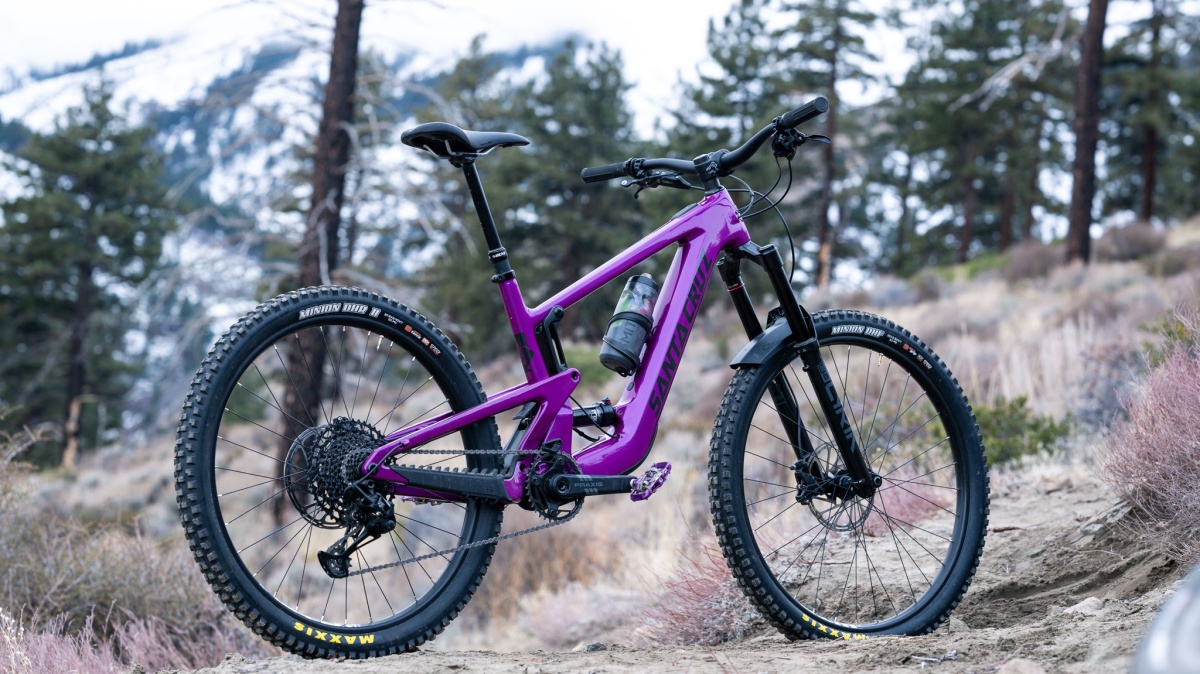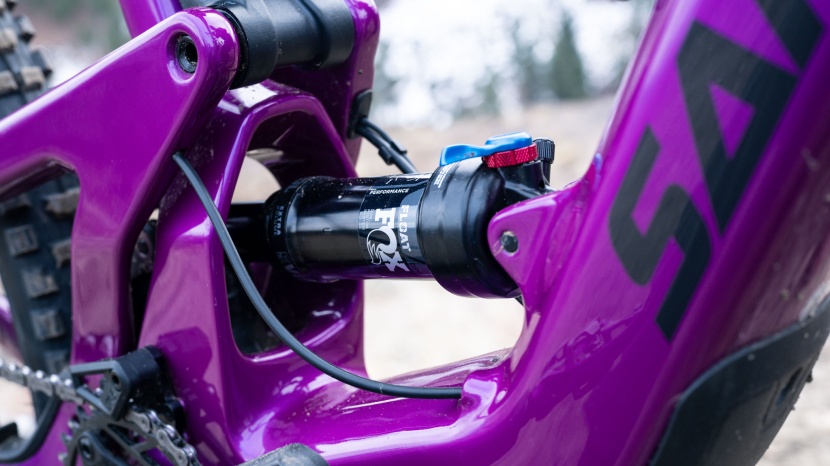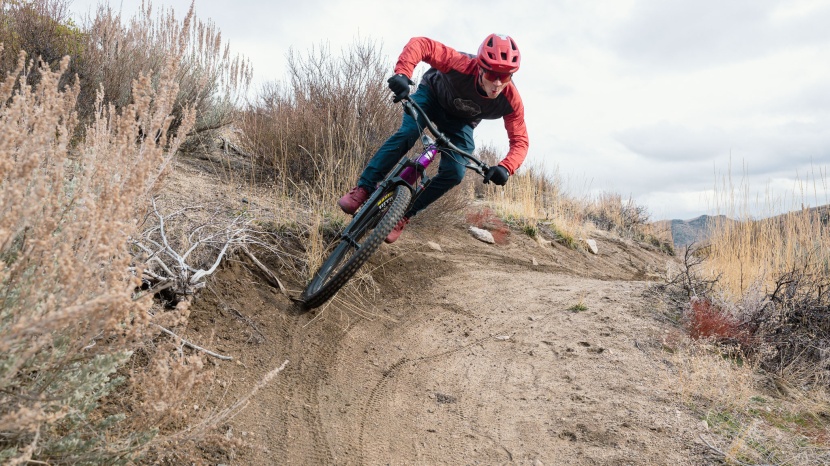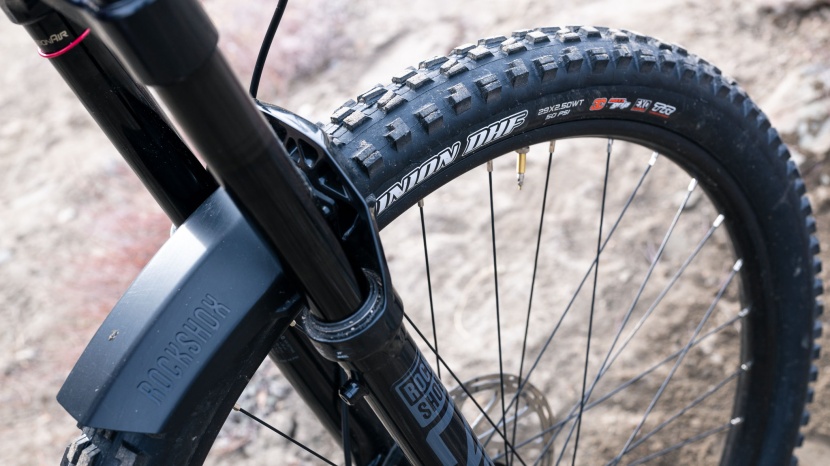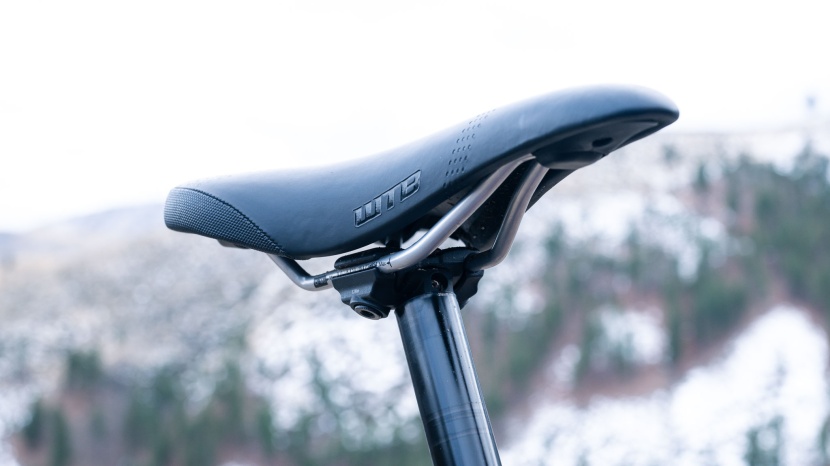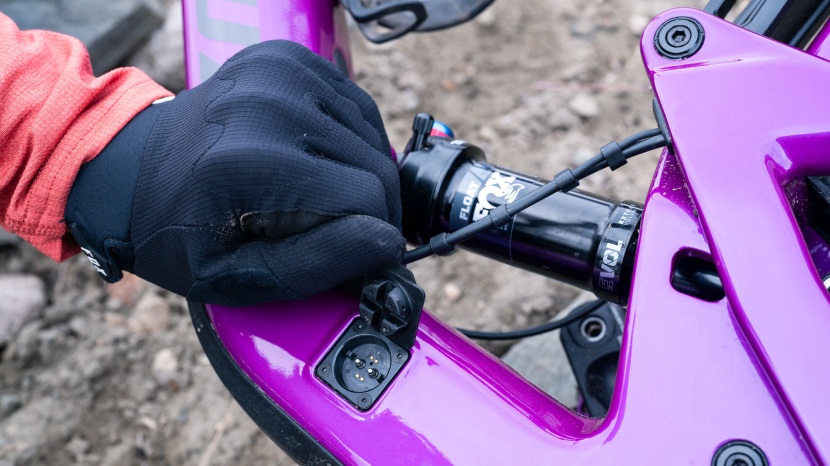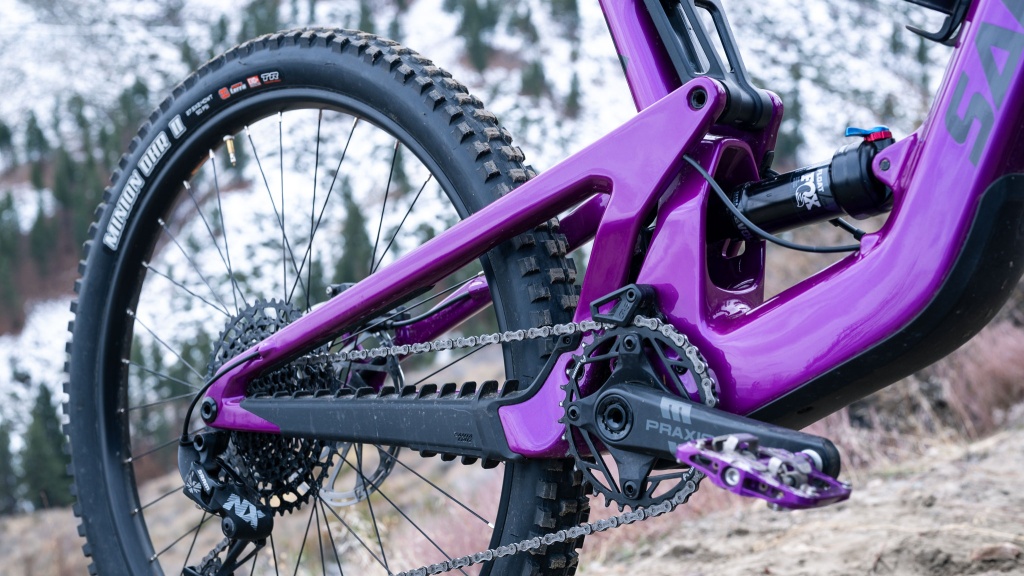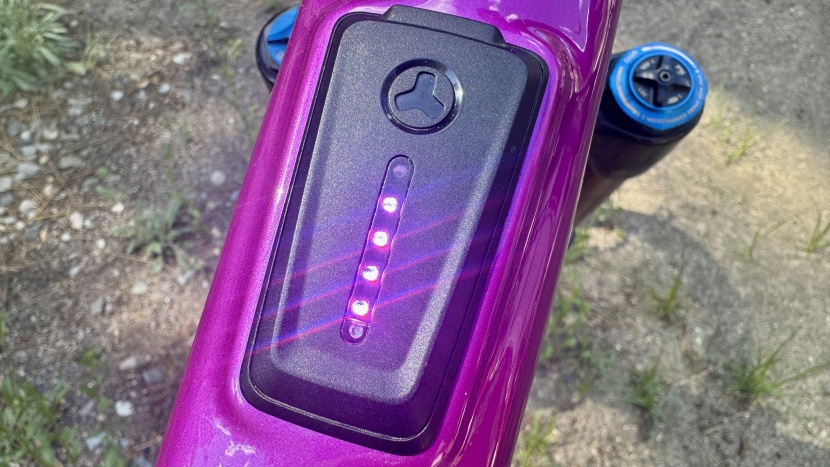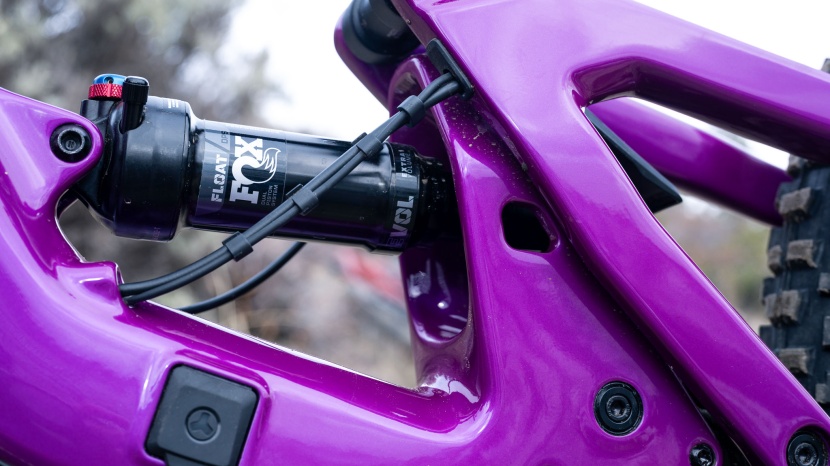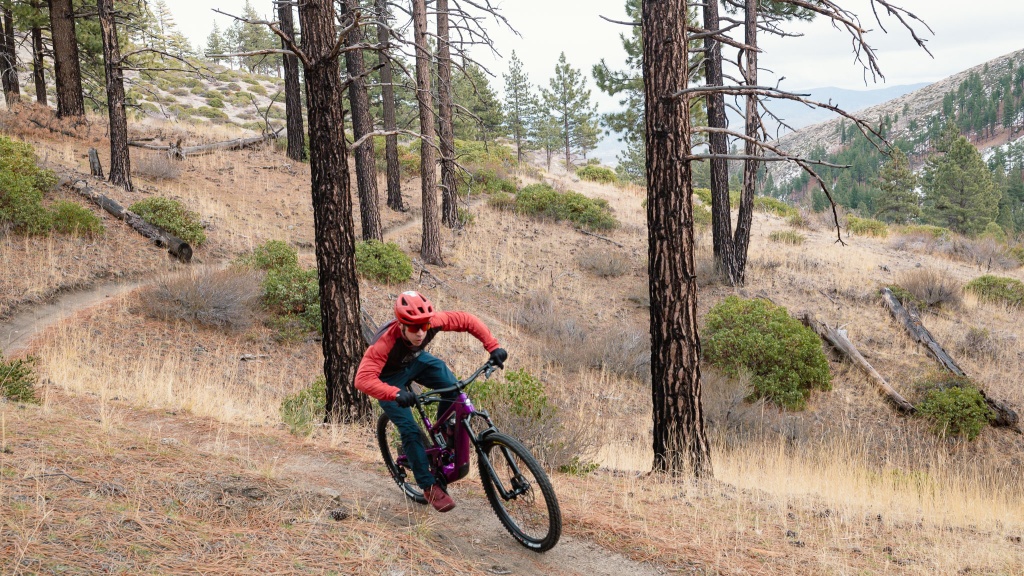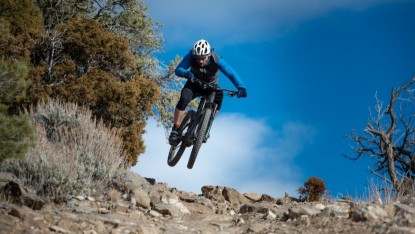
Our Verdict
Our Analysis and Test Results
Santa Cruz puts their best foot forward and basically slips a Fazua motor into the Bronson. The Fazua Ride 60 is among the growing class of lightweight motors that look to add less complexity, weight, and power to your electric ride. The current generation of MX wheeled VPP bikes seems like the perfect platform for electrification and we loved the last Bronson we tested. We were particularly impressed with its handling and playfulness. The Heckler SL is almost 14 pounds heavier than said Bronson, and that doesn't go unnoticed, even with an added 60Nm of torque added to your power. A 430Wh battery gives the Heckler SL a bit more juice than any of its mid-power competitors, so how does it fair?
Design Highlights
- Available in C and CC carbon frames, sizes S, M, L, XL, and XXL.
- Fazua Ride 60 motor delivers 60 Nm of torque, 250-watt nominal, 350-watt peak power
- MX Wheels (29F / 27.5R)
- 150mm VPP (Virtual Pivot Point) suspension / 160mm RockShox Lyrik fork
- Adjustable geometry with Flip-Chip
- 430Wh battery
Frame Design
The Santa Cruz Heckler SL was built around the Fazua Ride 60 motor and a large 430Wh downtube battery. These components don't dominate the bike's design the way they do on a full-power e-bike, but they did impact its design. The 150mm VPP frame grows a bit of rear center and, consequently, a bit of wheelbase. Like other current-generation Santa Cruz VPP bikes, the bike features a Flip-Chip that allows you to drop the bottom bracket height and slightly relax the head and seat tube angles. The downtube battery gobbles up the space that Santa Cruz normally uses for the glove box, but they still managed room for a full-sized water bottle and shock with a reservoir. The lines between analog and electric bikes have continued to blur, but the Heckler SL looks more like an e-bike than some of its mid-power competitors. A steep seat tube (77.5, 77.2) and slack front end (64.3, 64) give the bike climbing and descending chops, while a slightly elongated top tube provides room in between.
Downhill Performance
The Heckler SL is an electric Bronson at first glance, and we loved the current generation of Bronson, so we knew this bike was going to be fun. The additional weight of this bike gives it a more planted feeling with legendary grip. The front end is slack enough that it feels composed at high speeds and the bike is light enough that you never get the anchor sensation we felt on the full-power Heckler. The bike's mass doesn't disappear, but it's generally a positive feeling, creating traction and pushing the low bb deeper into corners. Some of that mass works as a silencer as the bike avoids unwanted jostling or being pushed around.
The SL still feels sporty on the way down; there's only a little extra gravity with bunny hops or side hits. Full send air on this bike is confidence-inspiring with enduro flavor. While the Heckler SL geometry is quite close to that of its analog cousin, the Bronson, there are some differences in the way it responds to the trail. Part of the Bronson's magic is its nimbleness, and this bike loses much of that nimble agility. It doesn't feel magnetized to the earth's core, but it has enough weight to affect its handling. The wheelbase is about 13mm (1263.4mm in low) longer than that of the Bronson, and that adds some stability at blurry speeds, but it also introduces a more lethargic nature since half of that growth is in the rear center. The top tube is a few millimeters shy of the Bronson's due to almost half a degree of headtube angle slackening. Comparing the geometry charts doesn't show a huge difference in these bikes but the geometries feel quite different in practice. The Heckler SL's 64-degree headtube angle (in low) instills plenty of confidence, but it loses some of the playfulness that we so loved about the Bronson.
The Heckler SL's suspension feels balanced with that characteristic VPP stability. Loads of deep stroke stability with decent anti-squat. The suspension pairs well with the motor, allowing you to charge off the line like you're wearing a number plate; the platform feels supportive yet reactive to trail input. The rear end seems to mute small bumps better than other mid-travel VPP bikes with its mass keeping checks on traction. Mid-stroke performance shines on bigger hits with a supportive ramp-up toward the end of the stroke. Despite some deep and abrupt dives into the latter half of the shock travel, we never found a harsh bottom. The Fox Float DPS supported rear end pairs well with the RockShox Lyrik Base fork, and while neither of the suspension components is particularly high-end, you wouldn't know it from the ride. The balance of support and stroke feels near ideal in most situations.
Undoubtedly, the 44lb 6oz curb weight of this bike contributed to its descending prowess. The bike's mass is masked by the motor's power in some situations, but its low center of gravity comes out to play in the fast corners and bar-wrangling slaloms. It's still playful in the air but resists the whips and near-flat table tops that we found addictive on the Bronson. In slower speeds technical sections where you need to rely on muscling the bike, the weight feels like less of an asset. Whether it's the extra pounds of motor and battery or the tweaks to the geometry, it couldn't feel less like the Bronson when it was time to finesse. Those who enjoy a stealthy, quiet bike should be forewarned that the drive unit is louder than the other mid-power bikes with a distinctive whine. The drive unit also makes a ratcheting noise like a freehub body when you backpedal.
The R build is the lowest-priced build for the Heckler SL, but its build didn't disappoint. The suspension doesn't offer much in the way of dampening adjustments but feels more than adequate for the majority of the terrain we rode. The cockpit is made up of e.13's 800mm aluminum bar, 40mm stem, and an SDG Tellis dropper post. The front end feels fairly stiff and responsive with some comfort provided by the thick Burgtec Bartender lock-on grips. The dropper retracts 170mm on our large test bike, and the Tellis gave us no issues during testing. SRAM DB8 brakes felt less refined than some of the Guide models, but paired with 200mm rotors, they made slowing our roll feel effortless, and we appreciated their use of mineral oil instead of DOT5. SRAM MTH hubs inside of WTB ST i30 rims don't exactly wow, but they stayed true and set up tubeless easily. The rear hub uses a Shimano HG freehub body and SRAM 1230 cassette, this means that upgrading to a nicer SRAM Eagle cassette isn't possible on this wheel. Maxxis Minion tires handle the connection with the ground, kudos to Santa Cruz for the EXO+ casing on the rear DHR 3C MaxxTerra 2.4 tire. The additional weight of this bike, coupled with the aggressive way it wants to be ridden, necessitates a burlier casing in the rear. A 2.5" Minion DHF 3C MaxxGrip EXO casing tire up front is the ideal choice for this bike providing optimal traction and handling.
Climbing Performance
The Heckler SL is a comfortable and capable climber but sets itself apart from the traditional e-mtbs because it is less powerful. This isn't the bike to soft-pedal and have the bike do all of the uphill work for you. Instead, this is the bike for the rider who wants to push their watts and have a little help to go a little faster or further. That said, it has efficient modern climbing geometry with a super steep 77.5-seat tube, putting you in a powerful pedaling position. The lesser amounts of pedal assistance will be just right for many riders looking to still ring that cardio bell.
The 64.3-degree (high) headtube angle helps the front end wander more than we'd like, so your upper body needs to work a little harder to keep the front end under control. The reach is quite long at 480mm so there's certainly some room to get comfortable and move around but the seat tube is so steep that you don't need to pull forward and ride the rivet to stay in an optimal power position. 443mm chainstays don't exactly keep it tight in the rear but they work well when climbing less technical terrain. Switchbacks aren't the bike's forte, but the motor's power allows you to lean in lower and earlier to make the most of the corners.
For the most part, we enjoyed climbing on the Heckler SL as its power neither overwhelmed the experience nor underwhelmed our legs. We could keep higher speeds and flow through uphill areas in a way that just isn't possible on an analog trail bike. The power coming from the Fazua motor doesn't always feel consistent and despite adjusting the power and ramp-up in the app, it still felt inconsistent at times. Compared to the newest iteration of the Specialized Levo SL motor or TQ motor on the Trek EXe, the Fazua feels less refined. The Fazua Ride 60 is a powerful little unit, but it won't do the climbing for you as a full-power motor can. Climbing on the Heckler can be immensely rewarding as you still get a solid boost of power, but making the most of it requires whole-body fitness. Pushing the bike hard requires a bit more muscle up top and as much leg power as you want to give it. If you choose to lean too heavily on the motor your rides will be shorter, there is currently no range extender available for this bike.
The VPP rear end isn't the most efficient of the climbing platforms but it does offer exceptional traction. The Fox Float DPS shock was valved perfectly for this bike, we found the climb switch useful for long grinds but otherwise left the shock wide open. There are times we may have wanted to fuss with the shock while riding, but its location deep in the frame means you practically rest your face on the handlebar to reach it, so we just left it open. The SRAM NX Eagle drivetrain felt adequate from a performance standpoint but a low point on a bike in this price range. The Eagle drivetrain offers a 490% range, which is excellent for climbing, but its weight felt less welcome on the ascent.
Power Output
One thing setting the Heckler SL apart, other than its weight, is that it technically delivers more torque than the other lightweight e-bikes. As the namesake may suggest, the Fazua Ride 60 generates 60Nm of torque, while a new Specialized Levo SL motor or TQ motor found on a Trek EXe generates only 50Nm of torque. This gives the Heckler an edge on paper, but the consistency and integration of that power into the drivetrain distract from its “advantage.” A full-powered e-mtb can provide you 90-100Nm of torque but those motors draw quite a bit of power, requiring larger batteries, resulting in a heavier bike. The Heckler SL attempts to strike a balance of power, weight, range, and cost. This bike still packs a punch and arguably gets the peak power right, but the weight, range, and cost are going to be subjective to the buyer.
This bike is best suited for riders who want to add a bit of extra speed or additional range to their fitness rides. The bike is powerful enough that we took it along with our full-powered friends and had a fine time, albeit on shorter rides but it's less fun to ride with friends who aren't on assisted bikes, the bike is just too fast. In the default Ride 60 settings, you can turn the assist down to the “Breeze” mode, and it cruises along, adding about 100 watts to your 125-watt input. It's certainly noticeable, but not as noticeable as the extra weight of the bike at slower speeds. Turning the power mode up to “River” adds about 250 watts of assistance to your 250 watts; this is the go-getter setting that pushes you the hardest and gives you the best ride on this bike. The “Rocket” mode adds a maximum of 350 watts to your 125-watt input, creating an exhilarating experience that is easy on your legs but hard on the battery.
Using the Fazua app, you can adjust the amount of assistance you get, how fast it ramps up, and at what power the bike will provide its maximum assistance. According to Fazua, “The Ramp-Up determines the responsiveness of the motor and the level of acceleration when starting. In the gentle setting, the motor kicks in with a slight delay and with light support for your riding, whereas in a reactive setting, the motor responds faster and provides you with more powerful acceleration.” As with all other Class 1 e-bikes, the power cuts out when you reach the maximum assisted speed of 20 mph, but legs willing, you can ride much faster than that.
Range
In the fast-growing market of lightweight, mid-power electric mountain bikes, the Heckler SL chose to go bigger on power and bigger on battery but not to accommodate a range extender. The 430Wh battery pack stuffed into the Santa Cruz downtube has more capacity than the Levo SL or Trek EXe at 320Wh and 360Wh, respectively. The 430Wh battery is amongst the largest available in a mid-power bike and may be the reason Santa Cruz chose not to offer a range extender.
Our 170 lb tester rode the Heckler SL in Rocket mode for 24.6 miles and almost 4,000 vertical feet up and down our range test hill. Testing the Heckler's range involved a fully charged battery, a Garmin Edge 830, and Garmin power meter pedals. Using the Fazua app, we adjusted the maximum power to 350 watts and lowered the wattage required to assist to the lowest setting of 90 watts. We monitored our power output in an attempt to give the bike minimal assistance and take maximum toll on the battery. What was interesting about the Fazua motor is that its assistance isn't consistent; it cuts out or drops off at seemingly random times and wattages with no relation to the bike's speed. Because of this, we had to pedal harder than we did on other bikes to keep the motor engaged. This test isn't exactly scientific, but we do our best to eliminate variables and give you a worst-case scenario on battery life. Since this range test is up and down, you can deduce the bike can climb approximately 12.3 miles in its “Rocket” setting. Even when we were pedaling at 200 watts, the motor would cut in and out, sometimes offering a stiff push and loud whir while other times tapering off into silence. All this said, take the Heckler's range with a grain of salt.
E-bike Controls
The controls on the Heckler SL are sleek, with a super low profile Ring Control thumb rocker. The rocker switch returns to the center, so each adjustment is quick and intuitive. It's the lightest and simplest form of remote we've seen, and while we had no issues with its durability, the thin plastic body and small gauge wire connector didn't give off a durable vibe. Pushing the Ring up increases the bike's power, down decreases the power, and pushing it inward engages the bike's walk mode. There is also an auxiliary function that we did not have hooked up, but pulling the ring outward will turn on a light that you can run through the bike's auxiliary port. We liked the ergonomics of the Ring Control, but it plays better with SRAM brake levers than Shimano; if it were a couple of millimeters thinner, it would fit the recess on Shimano levers and sit in an ideal spot. Fazua has this to say about it, “The minimalist RING CONTROL on the handlebar utilizes an incredibly intuitive design. Here, you can choose the support mode, turn on the light, and the walk assist – all without taking your eyes off the track.” We'd agree with all of this but argue that most ebike controls can be learned quickly so that you don't need to “take your eyes off the track.” On the top tube, the LED HUB has five colored LEDs that indicate your mode using color and the battery's charge by how many LEDs are illuminated. The hub also features a USB-C charging option under its cover. You can connect to the low-profile hub via Bluetooth or ANT+, and while it doesn't offer much information, it's sufficient for most rides. The LED lights are very bright, and in low-light riding conditions, they shine right up under our glasses, causing a distractingly bright glare from the top tube. There is no way to turn them off while keeping the bike powered, so we resorted to using a piece of electrical tape over the top during night rides.
Powering up the Heckler SL couldn't be easier; simply pushing the ring controller in either direction wakes the bike up within a couple of seconds. The LED hub lights up and immediately shows the battery level and ride mode. No words, no numbers, no bar charts or graphs, just five LED lights that convey all of the information you need; it's simple minimalism. The LED hub has no button or control so everything on the Heckler SL is controlled through the ring control. It's a very sleek and low-profile control that doesn't crowd the controls.
The battery charge port is located on the down tube on the non-drive side; it's mostly out of the way but sits in a spot that is prone to splash and debris. The location isn't ideal and the cranks can't be spun while it's plugged in. The latter point doesn't seem to be a big deal, but we were surprised how often we'd attempt to make an adjustment, lube the chain, or swap pedals and have to unplug the bike to make it happen. The Fazua charger we received with the bike was defective, and we've read multiple other accounts of faulty chargers, so, hopefully, that issue has been solved as it was a tough couple of weeks to have the bike and no charger that we wouldn't wish on anyone. Using the Fazua app, you can make changes to the level of assist as well as when that assist will kick in.
Build
As we stated above, the R build is the least expensive build of this model, but the parts kit doesn't distract from the bike's genius. Nothing about the build shines too brightly, but the suspension felt quite good for being a base model offering. The Lyrik's 35mm stanchions and robust lowers delivered steering accuracy and chatter reduction on par with the Fox 36 that we also rode the bike with. A SRAM NX Eagle drivetrain provides range aplenty, but its weight and inability to upgrade the cassette are unfortunate. For most riders, it will likely be sufficient, but spending time on SRAM's nicer drivetrains can raise your expectations and make you feel spoiled. All models use the same motor, battery, ring control, charger, cranks, and tires.
While the cockpit on the Heckler SL is nicely appointed with a WTB Silverado saddle and some e13 goods, there are plenty of opportunities for weight savings. If you want the best mix of performance and value, we think the SRAM GX AXS build at $9699 is the sweet spot for this bike. It's admittedly a large handful of cash, but the Transmission drivetrain and Reserve AL wheels would give this bike the performance parts it deserves and leave a pound or two behind.
Should You Buy the Santa Cruz Heckler SL?
The new Heckler SL is a trail slayer of a mid-power electric mountain bike that differentiates itself by offering more power and a larger battery. It doesn't have the weight burden of a full-power bike, but in this build, it's really not that much lighter. Unlike the new Levo SL and Trek Exe, riding the bike without the power doesn't really feel viable for long despite the Trek actually being heavier in the spec that we tested. The Fazua motor generated more torque than the other mid-power bikes were testing it next to but it doesn't feel as well integrated. You can adjust all of the parameters on the Fazua motor, but nothing makes it feel as seamless as the other mid-power bikes. All that said, it's still a brilliant bit of engineering with a somewhat fearless disposition that can provide a delightful trail experience. This is a great bike for the rider wanting flat-out descents with a little bit of help making that next ascent or extending their ride.
What Other Mid-Power Electric Mountain Bike Should You Consider?
The aforementioned Trek Fuel EXe 8 GX AXS Transmission and Specialized Levo SL are both brilliant bikes that appear very similar on paper. The TQ motor and software on the Trek give it the most advanced level of integration that makes the powered aspect disappear from your riding experience. With less travel and tighter geometry, it's slightly less aggressive but very well-mannered on the trail. The Levo SL weighs a bit less and has less range, but it can accommodate a range extender. It technically has less power, but that's not apparent when riding the bikes back to back. The TCU and motor integration were definite highlights on the Specialized with the bike feeling like a very polished product.
| Awards | |
|---|---|
| Price | $7,300 List Check Evo (on sale!) |
Overall Score  |
|
| Star Rating | |
| Bottom Line | An excellent bike in a crowded market, the Fazua motor feels less evolved than other mid-power e-bike motors but the bike is still a joy |
| Pros | Adaptive geometry, higher torque, bigger battery, MX wheels |
| Cons | Fazua motor integration, Value, No range extender, Indexed crank noise |
| Rating Categories | Santa Cruz Heckler SL R |
| Downhill Performance (30%) | |
| Climbing Performance (25%) | |
| Measured Effective Range (25%) | |
| Power Output (15%) | |
| E-Bike Controls (5%) | |
| Specifications | Santa Cruz Heckler SL R |
| Battery Size (Wh) | 430Wh |
| Wheel size (inches) | MX (29" front, 27.5" rear) |
| Motor System | Fazua Ride60 |
| Motor Power (torque) | 60Nm |
| Measured Weight (w/o pedals) | 44 lbs 6 oz (Large) |
| Measured Effective Range | 24.6 miles |
| Fork | RockShox Lyric, 160mm |
| Suspension & Travel | Virtual Pivot Point (VPP), 150mm |
| Shock | Fox Performance Float X |
| Frame Material | Carbon Fiber |
| Frame Size Tested | Large |
| Available Sizes | S-XXL |
| Wheelset | WTB ST i30 TCS |
| Front Tire | Maxxis Minion DHF 29 x2.5"WT, 3C MaxxGrip, EXO |
| Rear Tire | Maxxis Minion DHR II 27.5 x2.4", 3C MaxxTerra, EXO+ |
| Shifters | SRAM NX |
| Rear Derailleur | SRAM NX Eagle |
| Crankset | Praxis eTor AL |
| Crankarm length | 165mm |
| Cassette | SRAM PG1230, 11-50t |
| Chain | SRAM NX Eagle |
| Saddle | WTB Silverado |
| Seatpost | SDG Tellis Dropper 31.6 170mm |
| Handlebar | e13 TRS base |
| Stem | e13 40mm |
| Brakes | SRAM DB8 4-piston |
| Grips | Burgtec Bartender Pro |
| Measured Effective Top Tube (mm) | 621 |
| Measured Reach (mm) | 477 |
| Measured Head Tube Angle | 64.3 High/64 Low |
| Measured Seat Tube Angle (effective) | 77.5 High/ 77.2 Low |
| Measured Bottom Bracket Height (mm) | 344 High/341 Low |
| Measured Wheelbase (mm) | 1263 |
| Measured Chain Stay Length (mm) | 444 |


